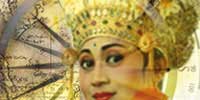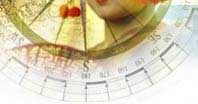|
JAKARTA (indo.com): Around 3,000 years ago when our Indonesian
ancestors started to settle down and become aware of the
need to have a vessels to put something in, they turned
to earth and converted it into earthenware water jars, cups
tempayan and the likes.
The making of earthenware vessels and terracotta objects
did not stagnate but, enhanced by the diversity of ethnic,
regional, past and current cultures, continued to develop
until today, with artists also using this medium for aesthetic
expression.
"Our ancestors did not make a wrong choice in making terracotta
objects that prevail from historical times until today,"
the National Museum's Director Endang Sri Hardiati told
indo.com recently.
The tradition of making terracotta objects in Indonesia
began in the pre-historic period, continued into the classical
period, then evolved with Islamic and European influences
into the contemporary period. Each period has its own characteristics,
uniqueness and masterpieces.
The techniques of terracotta making in this pre-historical
time were pinching, pedal and envil, techniques which later
developed into the use of the simple fast wheel. Products
made with these techniques include pots, cups, water jars
and funeral vessels, some of them decorated.
 In
the classical period, a time when the influences of Hindu
and Buddhism were very strong, the tradition of making terracotta
objects flourished in line with the concept of cosmology
developed by the religions. According to Hinduism and Buddhism,
the cosmos consists of five elements: earth, water, air,
fire and ether. "The earthenware items that have been fired
are called terracotta. Thus, terracotta has a significant
meaning in Hindu philosophy because it is made of earth
with water elements and is burnt in fire," she said. In
the classical period, a time when the influences of Hindu
and Buddhism were very strong, the tradition of making terracotta
objects flourished in line with the concept of cosmology
developed by the religions. According to Hinduism and Buddhism,
the cosmos consists of five elements: earth, water, air,
fire and ether. "The earthenware items that have been fired
are called terracotta. Thus, terracotta has a significant
meaning in Hindu philosophy because it is made of earth
with water elements and is burnt in fire," she said.
In this era, terracotta making was not confined to only
vessels and ceremonial objects. It was also used for construction
components, such as water pipes, bricks, roof decoration
and well walls. "Even in the era of the Majapahit Kingdom
in the 14th century, tops of wooden poles were covered with
decorated terracotta. This shows that terracotta making
was not only linked to daily utilitarian functions but also
served as a medium of artistic expression," she said.
In the era of the Majapahit Kingdom, large water jars were
beautifully decorated with reliefs. From the Madjapahit
era, a variety of savings boxes in the shape of animals
were made, including those shaped as pigs (piggy banks)
and other global forms with sound openings.
Various terracotta objects dating back to prehistoric times
as well as contemporary pieces are found all over the archipelago.
Great numbers of ancient terracotta pieces have been found
during excavations, and many more are still buried in the
various archaeological sites. Experts hold that the abundance
of terracotta finds indicates that this kind of pottery
has been produced by people over many millennia.
 Terracotta
objects belonging to pre-historic times have been discovered
in a number of sites including South Sulawesi, Jakarta,
East Java, West Java, Central Java, Bali, Sumba, Flores
and South Sulwesi.Terracotta from the classical period has
been found in North Sumatra, Jambi, South Sumatra, West
Java, East Java, Central Java and South Kalimantan. Terracotta
objects belonging to pre-historic times have been discovered
in a number of sites including South Sulawesi, Jakarta,
East Java, West Java, Central Java, Bali, Sumba, Flores
and South Sulwesi.Terracotta from the classical period has
been found in North Sumatra, Jambi, South Sumatra, West
Java, East Java, Central Java and South Kalimantan.
These ancient terracotta remains are now stored at the National
Museum in Jakarta and in archaeological centres outside
Jakarta, including in Palembang, South Sumatra and Banjarmasin
in Kalimanatan, West Java and East Java.
If you are a terracotta enthusiast and you happen to be
in Jakarta, then check out the National Museum, where over
300 terracotta pieces from various different areas in Indonesia
are on display. The works on view cover those made in pre-historic
times around 3000 years ago until modern era. The exhibition
commenced on November 26, 2000 and will run to January 31,
2000.
|







